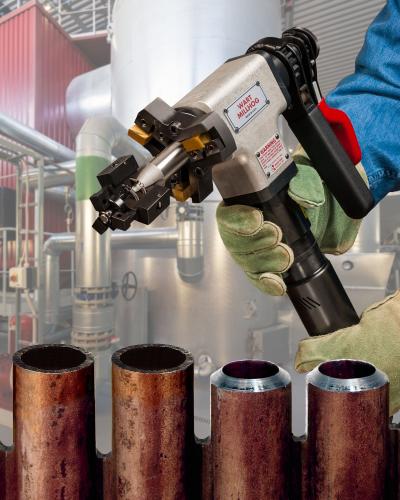
A pipe milling end prep tool for beveling water wall boiler tubes at biomass processing facilities in preparation for precision welding repairs is being introduced by Esco Tool. The Esco Wart MILLHOG is a boiler tube beveling machine that features a rigid ID clamping system and uses TiN-coated cutter blades to machine carbon steel or highly alloyed tubes without cutting fluids. Capable of beveling, facing and boring simultaneously, tooling changes are simple for machining water boiler tubes from 2” to 3” OD.
Rigidly attaching to the tube with clamps that fit into ID and expand on the mandrel using a self-centering draw rod assembly and attached wrenches, the Esco Wart MILLHOG boiler tube beveling machine is sealed to prevent debris from entering the tool. Designed with reliable dual opposed taper roller bearings, it is offered with pneumatic and electric motors.
Contact Details
Related Glossary Terms
- boring
boring
Enlarging a hole that already has been drilled or cored. Generally, it is an operation of truing the previously drilled hole with a single-point, lathe-type tool. Boring is essentially internal turning, in that usually a single-point cutting tool forms the internal shape. Some tools are available with two cutting edges to balance cutting forces.
- gang cutting ( milling)
gang cutting ( milling)
Machining with several cutters mounted on a single arbor, generally for simultaneous cutting.
- inner diameter ( ID)
inner diameter ( ID)
Dimension that defines the inside diameter of a cavity or hole. See OD, outer diameter.
- mandrel
mandrel
Workholder for turning that fits inside hollow workpieces. Types available include expanding, pin and threaded.
- milling
milling
Machining operation in which metal or other material is removed by applying power to a rotating cutter. In vertical milling, the cutting tool is mounted vertically on the spindle. In horizontal milling, the cutting tool is mounted horizontally, either directly on the spindle or on an arbor. Horizontal milling is further broken down into conventional milling, where the cutter rotates opposite the direction of feed, or “up” into the workpiece; and climb milling, where the cutter rotates in the direction of feed, or “down” into the workpiece. Milling operations include plane or surface milling, endmilling, facemilling, angle milling, form milling and profiling.
- outer diameter ( OD)
outer diameter ( OD)
Dimension that defines the exterior diameter of a cylindrical or round part. See ID, inner diameter.
